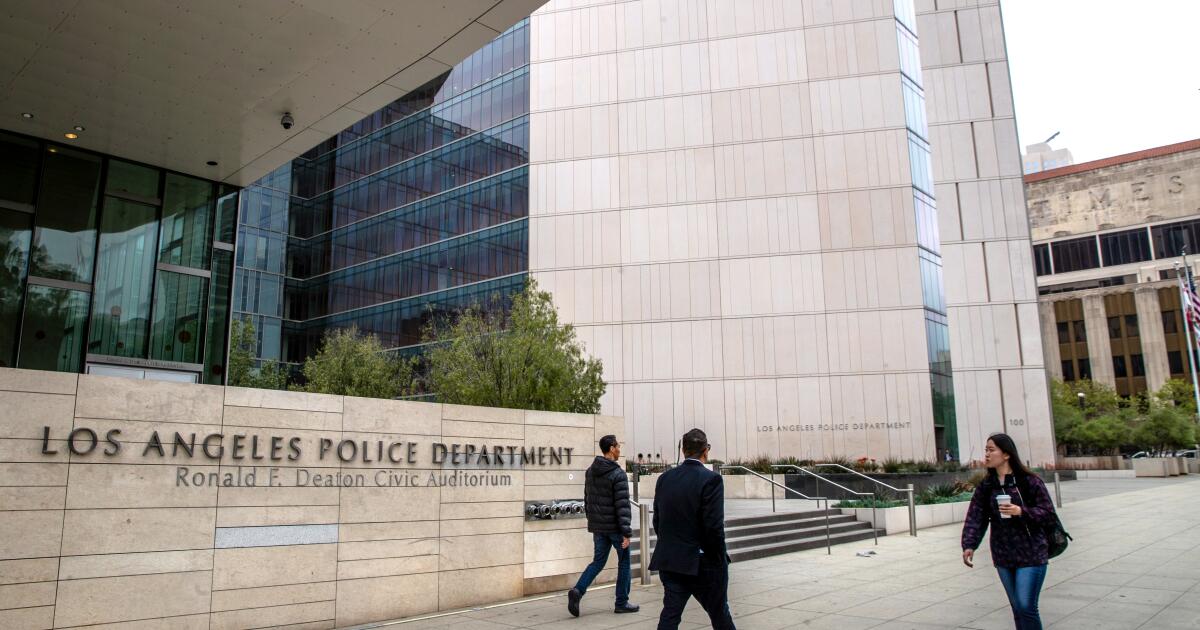She ran the L.A. animal shelters. Why couldn’t she fix the problems?
Staycee Dains was about a month into her job overseeing the Los Angeles city animal shelters when an employee openly defied her.
Dains asked the employee to clean a kennel. Instead, the employee picked up a hose and sprayed a dog in the face, Dains said.
Dains thought the employee should be fired, but she said the city’s personnel department recommended five days of leave.
Mayor Karen Bass hired Dains in June 2023 after promising to make L.A. “a national model for animal welfare” by turning around its troubled shelters, where dogs may live in overcrowded and dirty kennels and volunteers have complained that animals sometimes don’t get food and water.
But in an interview with The Times, Dains said she felt powerless to solve entrenched problems that included severe understaffing and employees who mistreated or neglected animals.
She said she was repeatedly told by the personnel department, which functions like a human resources department at a private company, that she couldn’t fire problem employees. She also clashed with one of the unions that represents shelter employees.
At one point, Dains even reached out to L.A. County prosecutors for help.
Meanwhile, as the overcrowding worsened, more dogs and cats were euthanized in city shelters under her watch than in the preceding years.
“We need to tell the unfiltered, unvarnished truth about what is happening in the shelters,” Dains said.
In August, after a little more than a year as Animal Services general manager, Dains went on paid leave. A few days later, a top Bass advisor told Dains that her last day would be Nov. 30 and that she was free to resign before then.
Zach Seidl, a Bass spokesperson, pushed back on Dains’ accusations.
“Many of these characterizations are misleading and some are just plain inaccurate,” he said in an email.
Dains, in a series of interviews, said the city does not provide enough funding to meet the basic needs of the animals in its six shelters.
During Bass’ first year in office, amid critical reporting by The Times and others about conditions in the shelters, the mayor offered an 18% budget increase — far less than the 56% the Animal Services department had requested. The following fiscal year, her budget proposal slightly lowered the department’s funding.
Last week, in passing a budget that closed a nearly $1-billion shortfall, the City Council spared Animal Services from major cuts.
Dains, who previously held top shelter jobs in San José and Long Beach, said her employees were desensitized to the suffering of the animals after witnessing it day after day. The understaffing was so bad that three people were responsible for 500 dogs: cleaning kennels, setting up adoptions and working with the medical team, she said.
“I couldn’t sleep knowing that animals were just in those hellholes suffering,” said Dains, who now works at a shelter system in Sacramento. “It was awful.”
Dains, who made about $273,000 a year in L.A., said she witnessed some of her employees “terrorizing” dogs by banging on their kennels, or spraying them with water to move them back. She told the employees to stop the behavior, but some said they had been trained to treat the dogs that way, she said.
To ensure that animals were fed and their enclosures cleaned, Dains suggested starting a schedule that tracked when each task was done. But a union representative worried that the information could be used to punish employees, Dains said.
Ultimately, Dains said, she dropped the proposal because of the opposition from the union, Laborers’ International Union of North America Local 300. A representative from the union declined to comment.
Dain said that personal entanglements and gossip among employees sometimes made it hard to hold them accountable.
Some supervisors had had sexual relationships with their subordinates, which led them to overlook the employees’ poor work performance, according to Dains. Others used the “dirt” they had on co-workers to protest when confronted about their own behavior, she said.
Dains said she suspected that some employees were sleeping during night shifts instead of cleaning cages or doing paperwork. She showed The Times a photo of dog beds arranged on the floor of a staff room like a “nest.”
She said she also witnessed employees watching videos on their phones, rather than working. Others ignored people who walked into the shelter looking to adopt a pet, she said. Some employees told her that colleagues failed to give food or water to cats and dogs.
At the same time, Dains said, other employees went “above and beyond constantly” to make up for those who didn’t pull their weight.
“There’s a significant portion of staff that just aren’t doing their jobs,” she said. “I saw this constantly.”
Dains put some of the blame on supervisors, who were “not requiring them to perform.”
When she tried to discipline supervisors, she faced pushback, she said.
After she put a supervisor on leave who was accused of bullying people, Laborers’ International Union of North America Local 300 filed a grievance against her, Dains said.
A spokesperson for the personnel department declined to comment.
At the same time, Dains acknowledged that she should have been tougher on some of the assistant general managers who reported directly to her. But she said she wanted to maintain working relationships with them.
It is a “tricky thing to do to start writing up executive-level managers that you are trying to work with,” she said.
A shelter employee, who requested anonymity because he didn’t have permission to talk to the media, agreed with Dains’ assessment.
“There’s no accountability, there’s no repercussions,” he said. “And the staff who do work have to work twice as hard.”
A report last year by Best Friends Animal Society, which highlighted the poor conditions in the shelters and suggested possible solutions, criticized Dains as the “biggest barrier” to improvement.
The shelters lacked written protocols, and the euthanasia policy “changed five times in the last year” without communication about the changes, the report said.
According to a Times analysis, the number of dogs euthanized at city shelters from January through September last year increased 72% compared with the same period the previous year. The number of dogs entering the shelters increased each year since 2022, but the number put to death far outpaced the population gain.
In the crowded conditions, animals started behaving poorly and suffered “mental and emotional breakdown,” according to the Best Friends report. That made them less likely to be adopted and more likely to be euthanized.
Dains, in her interview with The Times, defended her euthanasia decisions, arguing that it wasn’t safe for the animals, staff, volunteers or the public to “warehouse” dogs in kennels for months or years.
She said that there was no euthanasia policy when she arrived and that the department was creating one during her tenure.
Bass was Dains’ boss, but Dains’ main contact was Jacqueline Hamilton, deputy mayor of neighborhood services. Dains said she spoke often with Hamilton and told her about the personnel problems and other issues. But Hamilton didn’t offer any meaningful help and didn’t want her to publicize the poor conditions at the shelters, Dains said.
“I am not getting any movement or traction,” Dains told The Times, describing her work experience.
Seidl, the Bass spokesperson, said Dains “was given support to succeed, including assistance in communicating the status of the department to the public and decision makers.”
Dains said that shortly after she became general manager, she asked Deputy Dist. Atty. Kimberly Abourezk, who worked on animal cruelty cases, to send a letter to the mayor about poor conditions at the shelters.
Venusse D. Dunn, a spokesperson for the district attorney’s office, said Abourezk didn’t send the letter because she visited city animal shelters and didn’t find evidence of any crimes.
The office “is not in a position to tell another agency how to operate their facility,” Dunn said.
Annette Ramirez, a longtime Animal Services staffer, is now interim general manager. The “severe overcrowding crisis,” as the department described it in news release this month, continues.

